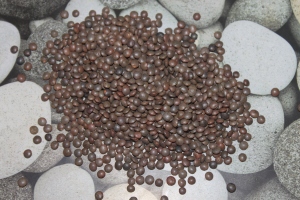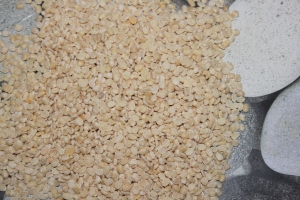An Introduction to Lentils: Lentils 101
Being vegetarians, my family has always had lentils as the main source of protein. Although lentils (or Daal) form a part of our daily diet, we do not consume the same type of lentils every day. There is a huge variety of lentils available and each of them can be prepared in a number of ways.
Nevertheless, every household would generally have a few of their favourite lentils and I am giving below a basic introduction on various lentils that I mostly use (and ordinarily we do use a good selection of them). I have deliberately excluded Beans (Kidney Beans, Chickpeas, Black eyed beans etc) from the explanation below, because these are generally better understood than lentils and commonly used around the world. In any case, Beans are actually Legumes, just as Lentils are.
Types of Lentils
If you are new to cooking lentils, it is best to start with the Green Gram (Moong) or Split Red Gram (Arhar), as these are the easiest to handle and take on the flavours of spices well.
Moong Daal (Green Gram): Whole, Split and Washed
Moong Daal Whole (Green Gram, whole): The most nutritious of all lentils, it goes well with rice or flat breads (chappati). It can also be sprouted easily. These lentils are unhulled & whole and need a longer time to cook than the split or wash variety. The cooking time can be slightly reduced by soaking in water for at least 15 minutes before cooking. With high fiber content, the Daal is very filling. Moong Daal soup is also very good for detox and weight loss. Also, for the purpose of sprouting, Moong Daal is probably the most nutritious and easiest.
Moong Daal Split (Split Green Gram): This is the green gram split, but not skinned. Next to whole moong in nutrition, it takes less time to cook and is easier to digest. Can also be cooked along with Spinach to enhance its nutritional value. It is also very commonly used to make Khichri (a kind of stew or congee made with lentils and rice). Cheelas (Savoury pancakes) made out of split green lentils are also a common breakfast in some parts of India.
Moong Daal Wash (Washed Green Gram/ Hulled Green Gram/ Yellow Moong Gram): These have had the husk removed, generally yellow in colour and the fastest to cook, even if not soaked. These can also be used to make small vadas/ dumplings, although the Urad wash daal is more popular for vadas. But vadas made out of Moong daal are lighter than the Urad daal. These lentils can be used to make cheelas or yummy moong daal halwa (pudding).
Because of its high nutrition value and easy to digest Moong daal soups and khichri are an ideal food for the sick and people who are recovering from illness.
Arhar Daal/ Toovar Daal (Split Pigeon Pea)
Toovar Daal has a very thick, smooth consistency when cooked and is probably the most popular daal throughout India. Low fat, cholesterol free and rich in vitamins and minerals, it can be used to make simple daal or aromatic sambhar, delicious khichri and tangy rasam to go along with idlis. Although it can be prepared in many ways, the daal tastes great even just with a simple tempering of ghee, asafoetida (hing), cumin (jeera) and chili.
Chana Daal (Split Bengal Gram)
Chana Daal is generally prepared in combination with other daals like urad wash or urad split or with vegetables like bottle gourd, squashes or spinach. It has a rich texture and low glycemic index. It is however, heavier to digest than the Green Gram.
The flour of Bengal Gram, Besan, is also widely used and easily available at all Indian grocery stores. It is useful as a binding or thickening agent, and also used for making fritters or pakoras and dhoklas. It is also very easy to prepare cheelas and halwa out of Split Bengal Gram flour.
Masoor Daal ( Pink Lentils)
Masoor Daal is another popular and nutritious daal, rich in dietary fiber, protein and iron. It is used in both whole and washed varieties. Washed Massor (Pink Lentils) are sometimes used as a substitute for Arhar Daal because it is generally cheaper than Arhar daal. We generally prefer to use the Masoor Whole in our kitchen.
Urad Daal (Black Gram): Whole, Split and Washed
Urad Daal, whole (Black Gram, whole): Black gram provides proteins, fat and carbohydrates and also contains iron, calcium, magnesium, potassium and B vitamins. It is very popular in North India. Well known as Daal Makhani, it takes the longest to cook. However, urad daal is heavier to digest than most other lentils and causes bloating. It is best to cook these with ginger and garlic to aid digestion. Urad Daal must be soaked for an hour before cooking and change the water before boiling the daal. I also like to keep removing the froth that forms while boiling the daal.
Urad Daal, split (Black Gram, split): Probably, less popular than the other daals, it is generally prepared in combination with other daals like the Bengal Gram. Like Urad whole, urad split is also heavy and must be cooked with ginger and garlic to aid digestion.
Urad Daal, wash (Black Gram, washed): As a daal, it has almost a bland flavour, and generally prepared in combination with Bengal Gram. The Daal tastes delicious when prepared with ginger, garlic and onion, amongst other spices. It is more commonly used in South India, where it is ground to a paste and used to make dosa, idli and vadas.
While preparing the ever popular Khichri, generally Moong daal is preferred because it is easier to digest, but Khichri prepared with urad daal also has its unique benefits. This Khichri, eaten with a lot of ghee (clarified butter) helps clean the digestive track.
Buying and Storage
– It is always better to cook dried lentils. Freshly cooked lentils taste much better than the canned ones.
– When purchasing, one must see that the lentil pack does not have powdered lentils or dust at the bottom of the pack or the lentils do not have tiny holes in them. These are both indicators that lentils are already infested with worms.
– Lentils must be stored in air tight containers, in a cool dark place and away from moisture.
– Avoid using wet hands or spoons to scoop the lentils from its container. Especially the whole/ unhulled versions are more prone to getting infested.
– Dried lentils, when stored properly, have an indefinite shelf life, but ideally should be consumed within one year. Also, in case of the “whole” varieties, it would be better if these are bought in smaller quantities and consumed within a few months.
– Lastly, when stocking a new pack of lentils, they must be stored in a separate container and not mixed with the old lentils, even if they are the same variety.
Basic Cooking techniques:
For a very basic and quick preparation, take a bowl of lentils, clean, wash and soak for 15 minutes. Next cook with salt and half a teaspoon of turmeric powder. Next heat a couple of tablespoons of Ghee in a separate pan and add a pinch of asefotida (hing) and a teaspoon of cumin seeds. Once the cumin splutters, add a couple of tablespoons of tomato puree, chili powder as per taste and half a teaspoon of garam masala and sauté for a few minutes. Add this tempering to the boiled lentils and serve hot with another sprinkle of ghee and fresh coriander on top. This basic recipe should work with most daals.
Another easy and popular method is to skip the tomatoes as well. This works well with Moong Wash and Arhar daal: take 2 tablespoons of Ghee in a pan and warm it, add asafetida & cumin seeds (or mustard seeds). Once the cumin splurts, lower the heat and add red chili powder. Let it roast taking care not to burn it (it should not turn black). Sprinkle this ghee generously over a bowl of boiled lentils, sprinkle fresh coriander leaves and serve immediately with steamed rice or flat breads.
As a general indication, the moong daals tend to be slightly bland as compared to other daals, so need some spicing up with ginger, onions and tomatoes. The urad daals tend to cause gas and bloating so must be cooked with some ginger and garlic. The arhar/ toor daal is very popular and richer in taste than other daals. It can even be had with a simple tendering of ghee, cumin or mustard seeds and chilli powder.
Tips:
– Lentils have a low fat content and a good source of protein, vitamin B complex, potassium and several other nutrients.
– All lentils must be soaked in water before cooking . This not only reduces the cooking time, but also makes the lentils somewhat easier to digest.
– People with a tendency of acidity or bloating should avoid urad daal before bedtime. But moong daal is easier to digest and can be had for dinner as well.
– Important to wash the lentils several times before cooking. I generally soak them and then wash several times until the water is clear and not cloudy anymore.
– For western recipes, try adding half a cup of par-boiled lentils to salads or soups, or simply add sprouted lentils to daily breakfast.
Lentils are low in fat, a powerhouse of nutrition and very easy to cook. They can be consumed as a main dish with rice, or as a comfort food like Khichri. Sprouting makes the lentils easier to digest and these can be easily sprouted at home. Lentils take on the flavours of spices well and can be easily combined with veggies to make a filling and healthy meal. Vegan, dairy free and gluten free, lentils are a much have for any household.










Recent Comments